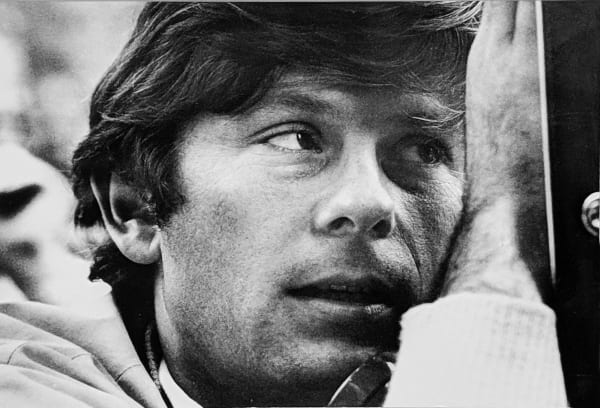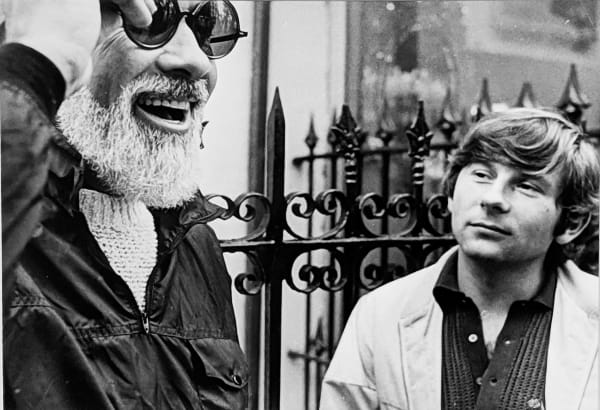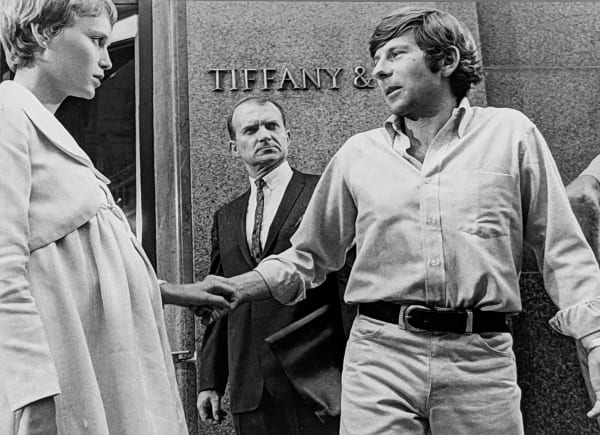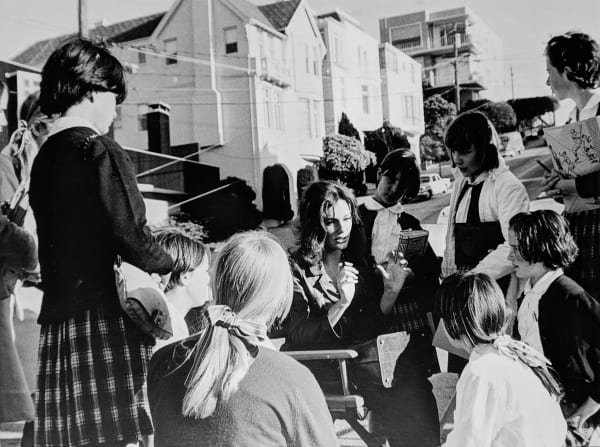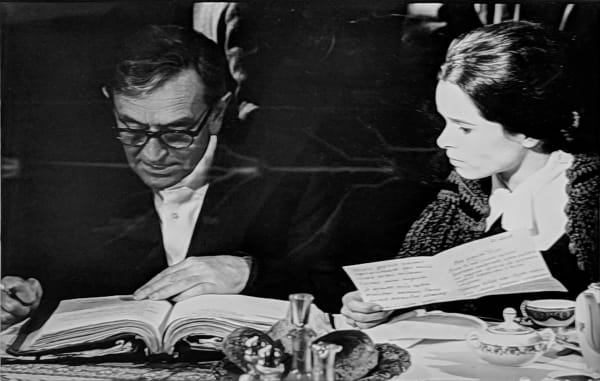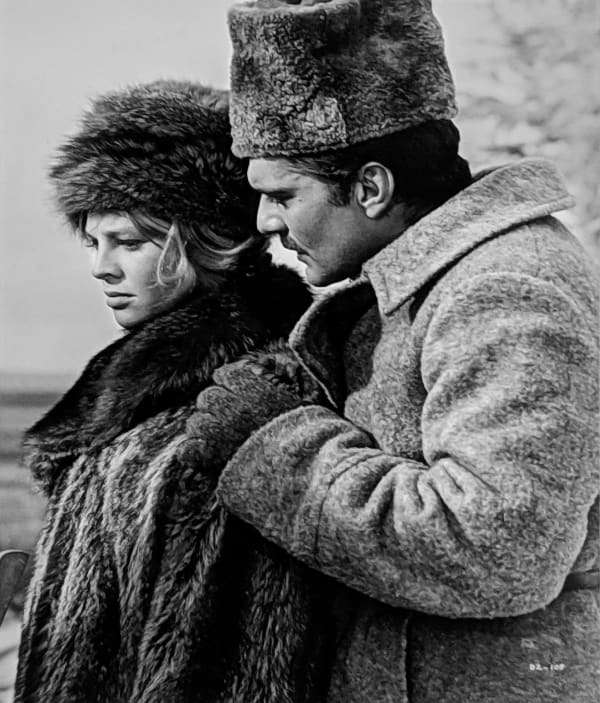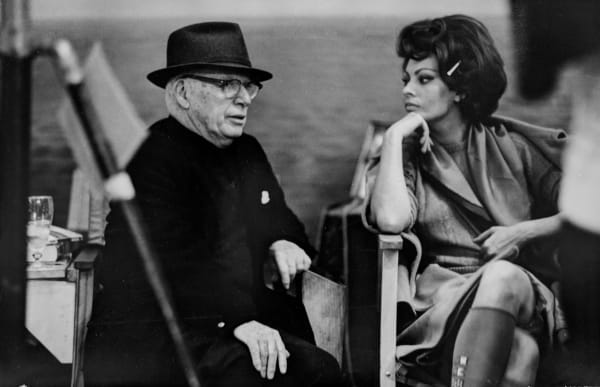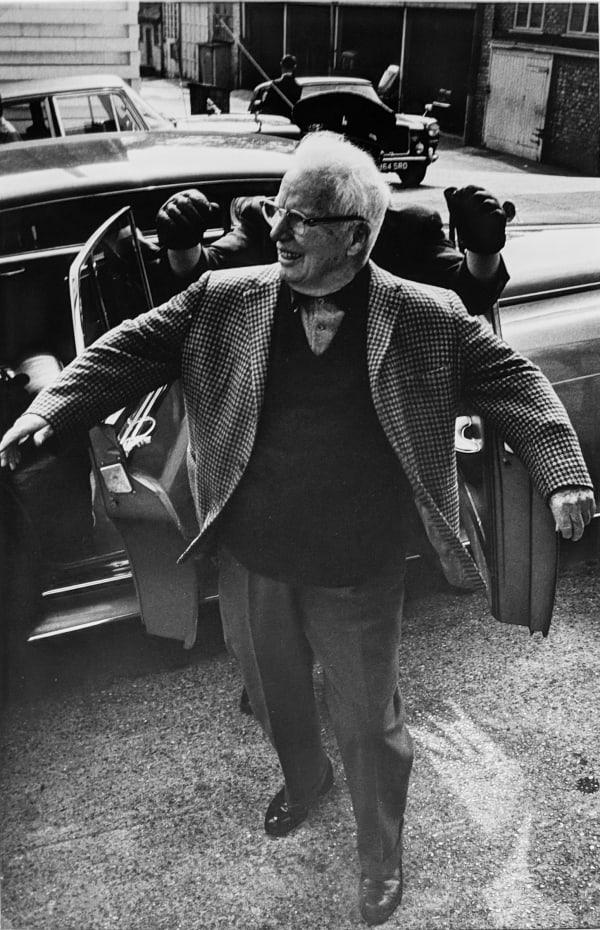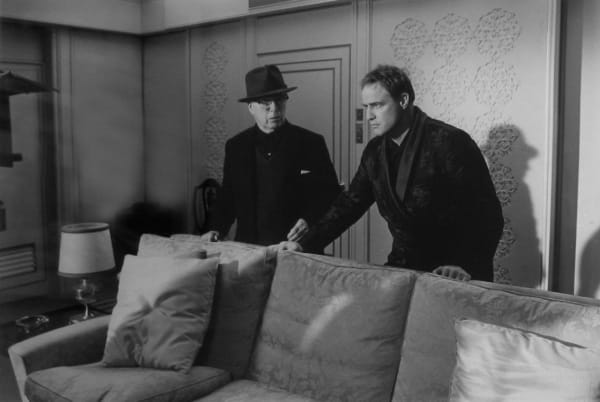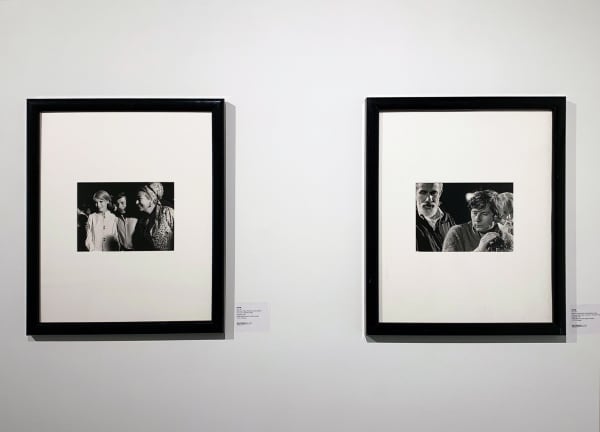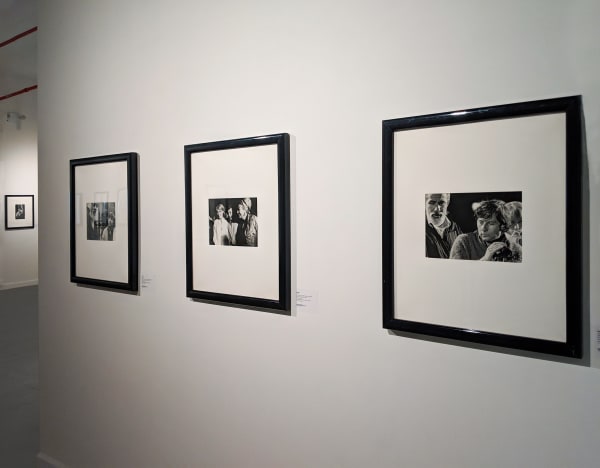Director's Cut: 1960s Vintage Photographs
WESTWOOD GALLERY NYC presents a premiere exhibition of vintage film set photography by Hatami (1928–2017), the celebrated photojournalist known for capturing both world events and cultural icons.
On view are rare behind-the-scenes images from landmark 1960s productions including Rosemary’s Baby (Roman Polanski), Bullitt (Peter Yates), A Countess from Hong Kong (Charlie Chaplin), and Doctor Zhivago (David Lean). These intimate photographs reveal directors and actors at work, offering a candid look into the creative process at a pivotal moment in film history.
Renowned for his six-decade career spanning political upheavals, Hollywood legends, fashion icons, and cultural revolutions, Hatami’s archive stands as a testament to photography’s power to preserve both history and artistry.
-
 Hatami, Mia Farrow and Maurice Evans taking a break, walking in lower Manhattan, New York City, on the set of “Rosemary’s Baby”, 1968
Hatami, Mia Farrow and Maurice Evans taking a break, walking in lower Manhattan, New York City, on the set of “Rosemary’s Baby”, 1968 -
 Hatami, Roman Polanski directing Mia Farrow on Madison Avenue, New York City, on the set of “Rosemary's Baby”, 1968
Hatami, Roman Polanski directing Mia Farrow on Madison Avenue, New York City, on the set of “Rosemary's Baby”, 1968 -
 Hatami, Roman Polanski visualizing a shot, New York City, on the set of “Rosemary's Baby”, 1968
Hatami, Roman Polanski visualizing a shot, New York City, on the set of “Rosemary's Baby”, 1968 -
 Hatami, William A. Fraker (director of photography), Roman Polanski and Mia Farrow, New York City, on the set of “Rosemary's Baby”, 1968
Hatami, William A. Fraker (director of photography), Roman Polanski and Mia Farrow, New York City, on the set of “Rosemary's Baby”, 1968
-
 Hatami, William A. Fraker (director of Photography) and Roman Polanski, New York City, on the set of “Rosemary's Baby”, 1968
Hatami, William A. Fraker (director of Photography) and Roman Polanski, New York City, on the set of “Rosemary's Baby”, 1968 -
 Hatami, Mia Farrow, Roman Polanski, and Hanna Landy, New York City, on the set of “Rosemary's Baby”, 1968
Hatami, Mia Farrow, Roman Polanski, and Hanna Landy, New York City, on the set of “Rosemary's Baby”, 1968 -
 Hatami, Mia Farrow near Central Park, New York City, on the set of “Rosemary's Baby”, 1968
Hatami, Mia Farrow near Central Park, New York City, on the set of “Rosemary's Baby”, 1968 -
 Hatami, Mia Farrow in the Strand book store scene, New York City, on the set of “Rosemary's Baby”, 1968
Hatami, Mia Farrow in the Strand book store scene, New York City, on the set of “Rosemary's Baby”, 1968
-
 Hatami, Mia Farrow and Roman Polanski setting a scene in front of Tiffany, New York City, on the set of “Rosemary’s Baby”, 1968
Hatami, Mia Farrow and Roman Polanski setting a scene in front of Tiffany, New York City, on the set of “Rosemary’s Baby”, 1968 -
 Hatami, Mia Farrow practicing a tense scene, on the set of “Rosemary's Baby”, 1968
Hatami, Mia Farrow practicing a tense scene, on the set of “Rosemary's Baby”, 1968 -
 Hatami, Mia Farrow, Roman Polanski, and Joan Crawford, New York City, on the set of “Rosemary's Baby”, 1968
Hatami, Mia Farrow, Roman Polanski, and Joan Crawford, New York City, on the set of “Rosemary's Baby”, 1968 -
 Hatami, Roman Polanski and Mia Farrow in front of The Dakota Building, New York City, on the set of “Rosemary's Baby”, 1968
Hatami, Roman Polanski and Mia Farrow in front of The Dakota Building, New York City, on the set of “Rosemary's Baby”, 1968
-
 hatami, roman Polanski reviewing the script with Mia Farrow and William A. Fraker (director of photography) in the background, New York City, on the set of “Rosemary's Baby”, 1968
hatami, roman Polanski reviewing the script with Mia Farrow and William A. Fraker (director of photography) in the background, New York City, on the set of “Rosemary's Baby”, 1968 -
 Hatami, Roman Polanski, Mia Farrow, John Cassavetes and crew in front of The Dakota building, New York City, on the set of “Rosemary's Baby”, 1968
Hatami, Roman Polanski, Mia Farrow, John Cassavetes and crew in front of The Dakota building, New York City, on the set of “Rosemary's Baby”, 1968 -
 Hatami, Roman Polanski taking a break between takes, on the set of “Rosemary's Baby”, 1968
Hatami, Roman Polanski taking a break between takes, on the set of “Rosemary's Baby”, 1968 -
 Hatami, Steve McQueen, Peter Yates and crew discussing the next scene, on the set of “Bullitt”, 1968
Hatami, Steve McQueen, Peter Yates and crew discussing the next scene, on the set of “Bullitt”, 1968
-
 Hatami, Robert Vaughn, Steve McQueen and director Peter Yates setting up a shot, on the set of “Bullitt”, 1968
Hatami, Robert Vaughn, Steve McQueen and director Peter Yates setting up a shot, on the set of “Bullitt”, 1968 -
 Hatami, Jacqueline Bissett talking to a group of schoolgirls, on the set of “Bullitt”, 1968
Hatami, Jacqueline Bissett talking to a group of schoolgirls, on the set of “Bullitt”, 1968 -
 Hatami, Don Gordon and Steve McQueen on the set of “Bullitt”, 1968
Hatami, Don Gordon and Steve McQueen on the set of “Bullitt”, 1968 -
 Hatami, Steve McQueen signing autographs on the set of “Bullitt”, 1968
Hatami, Steve McQueen signing autographs on the set of “Bullitt”, 1968
-
 Hatami, Director Peter Yates, Steve McQueen and crew discussing a scene, on the set of “Bullitt”, 1968
Hatami, Director Peter Yates, Steve McQueen and crew discussing a scene, on the set of “Bullitt”, 1968 -
 Hatami, Jacqueline Bissett during the filming of the tram scene from “Bullitt”, 1968
Hatami, Jacqueline Bissett during the filming of the tram scene from “Bullitt”, 1968 -
 Hatami, Steve McQueen and Jacqueline Bissett conversing at lunch, on the set of “Bullitt", 1968
Hatami, Steve McQueen and Jacqueline Bissett conversing at lunch, on the set of “Bullitt", 1968 -
 Hatami, Steve McQueen between takes with police extras, on the set of “Bullitt”, 1968
Hatami, Steve McQueen between takes with police extras, on the set of “Bullitt”, 1968
-
 Hatami, Jacqueline Bissett and director Peter Yates during a lunch break, on the set of “Bullitt”, 1968
Hatami, Jacqueline Bissett and director Peter Yates during a lunch break, on the set of “Bullitt”, 1968 -
 Hatami, Geraldine Chaplin in the role of Tonya, preparing for a scene set up pre-Russian Revolution, on the set of “Doctor Zhivago” in Finland, 1965
Hatami, Geraldine Chaplin in the role of Tonya, preparing for a scene set up pre-Russian Revolution, on the set of “Doctor Zhivago” in Finland, 1965 -
 Hatami, Geraldine Chaplin practicing a scene during which she received a letter from Yuri Zhivago on the set of “Doctor Zhivago” in Finland, 1965
Hatami, Geraldine Chaplin practicing a scene during which she received a letter from Yuri Zhivago on the set of “Doctor Zhivago” in Finland, 1965 -
 Hatami, Scene where Lara and Yuri arrive at the Varykino estate, on the set of “Doctor Zhivago” in Finland, 1965
Hatami, Scene where Lara and Yuri arrive at the Varykino estate, on the set of “Doctor Zhivago” in Finland, 1965
-
 Hatami, Geraldine Chaplin in a scene depicting the Soviet Union, on the set of “Doctor Zhivago” in Finland, 1965
Hatami, Geraldine Chaplin in a scene depicting the Soviet Union, on the set of “Doctor Zhivago” in Finland, 1965 -
 Hatami, Omar Sharif in a winter scene which takes place in the Ural Mountains, on the set of “Doctor Zhivago” in Finland, 1965
Hatami, Omar Sharif in a winter scene which takes place in the Ural Mountains, on the set of “Doctor Zhivago” in Finland, 1965 -
 Hatami, Geraldine Chaplin and director David Lean reviewing the script, on the set of “Doctor Zhivago” in Finland, 1965
Hatami, Geraldine Chaplin and director David Lean reviewing the script, on the set of “Doctor Zhivago” in Finland, 1965 -
 Hatami, Geraldine Chaplin as Tonya on the set of “Doctor Zhivago” (Soviet propaganda images in the background), 1965
Hatami, Geraldine Chaplin as Tonya on the set of “Doctor Zhivago” (Soviet propaganda images in the background), 1965
-
 Hatami, Lara (Julie Christie) and Yuri (Omar Sharif), on the set of “Doctor Zhivago”, 1965
Hatami, Lara (Julie Christie) and Yuri (Omar Sharif), on the set of “Doctor Zhivago”, 1965 -
 Hatami, Geraldine Chaplin preparing for a scene in the harsh tundra, in Russia, on the set of “Doctor Zhivago” in Finland, 1965
Hatami, Geraldine Chaplin preparing for a scene in the harsh tundra, in Russia, on the set of “Doctor Zhivago” in Finland, 1965 -
 Hatami, Geraldine Chaplin on the set of “Doctor Zhivago”, 1965
Hatami, Geraldine Chaplin on the set of “Doctor Zhivago”, 1965 -
 Hatami, Julie Christie and Omar Sharif in a scene where Lara must depart, on the set of “Doctor Zhivago” in Finland, 1965
Hatami, Julie Christie and Omar Sharif in a scene where Lara must depart, on the set of “Doctor Zhivago” in Finland, 1965
-
 Hatami, Geraldine Chaplin and Omar Sharif in a scene where they are leaving Moscow for Varykino, on the set of “Doctor Zhivago” in Finland, 1965
Hatami, Geraldine Chaplin and Omar Sharif in a scene where they are leaving Moscow for Varykino, on the set of “Doctor Zhivago” in Finland, 1965 -
 Hatami, Geraldine Chaplin and Ralph Richardson practicing a scene, on the set of “Doctor Zhivago”, 1965
Hatami, Geraldine Chaplin and Ralph Richardson practicing a scene, on the set of “Doctor Zhivago”, 1965 -
 Hatami, Omar Sharif between takes on the set in Finland where parts of “Doctor Zhivago” were filmed, 1965
Hatami, Omar Sharif between takes on the set in Finland where parts of “Doctor Zhivago” were filmed, 1965 -
 Hatami, Director David Lean preparing a scene on the set of “Doctor Zhivago.” In the background is Geraldine Chaplin, 1965
Hatami, Director David Lean preparing a scene on the set of “Doctor Zhivago.” In the background is Geraldine Chaplin, 1965
-
 Hatami, Sophia Loren relaxing between takes on the set of “A Countess from Hong Kong,” Pinewood Studios, Buckinghamshire, 1966
Hatami, Sophia Loren relaxing between takes on the set of “A Countess from Hong Kong,” Pinewood Studios, Buckinghamshire, 1966 -
 Hatami, Sophia Loren and Charlie Chaplin on the set of “A Countess from Hong Kong,” Pinewood Studios, Buckinghamshire, 1966
Hatami, Sophia Loren and Charlie Chaplin on the set of “A Countess from Hong Kong,” Pinewood Studios, Buckinghamshire, 1966 -
 Hatami, Charlie Chaplin and Marlon Brando discussing a scene on the set of “A Countess from Hong Kong,” Pinewood Studios, Buckinghamshire, 1966
Hatami, Charlie Chaplin and Marlon Brando discussing a scene on the set of “A Countess from Hong Kong,” Pinewood Studios, Buckinghamshire, 1966 -
 Hatami, Charlie Chaplin and with his wife Oona O’Neill Pinewood Studios, Buckinghamshire, on the set of “A Countess from Hong Kong”, 1966
Hatami, Charlie Chaplin and with his wife Oona O’Neill Pinewood Studios, Buckinghamshire, on the set of “A Countess from Hong Kong”, 1966
-
 Hatami, Charlie Chaplin on the set of “A Countess from Hong Kong,” Pinewood Studios, Buckinghamshire, 1966
Hatami, Charlie Chaplin on the set of “A Countess from Hong Kong,” Pinewood Studios, Buckinghamshire, 1966 -
 Hatami, Sofia Loren with crew members in between takes, on the set of “A Countess from Hong Kong,” Pinewood Studios, Buckinghamshire, 1966
Hatami, Sofia Loren with crew members in between takes, on the set of “A Countess from Hong Kong,” Pinewood Studios, Buckinghamshire, 1966 -
 Hatami, Charlie Chaplin on the set of “A Countess from Hong Kong,” Pinewood Studios, Buckinghamshire, 1966
Hatami, Charlie Chaplin on the set of “A Countess from Hong Kong,” Pinewood Studios, Buckinghamshire, 1966 -
 Hatami, Charlie Chaplin conducting the score he composed for “A Countess from Hong Kong,” Pinewood Studios, Buckinghamshire, 1966
Hatami, Charlie Chaplin conducting the score he composed for “A Countess from Hong Kong,” Pinewood Studios, Buckinghamshire, 1966
-
 Hatami, Sophia Loren and Charlie Chaplin on the set of “A Countess from Hong Kong,” Pinewood Studios, Buckinghamshire, 1966
Hatami, Sophia Loren and Charlie Chaplin on the set of “A Countess from Hong Kong,” Pinewood Studios, Buckinghamshire, 1966 -
 Hatami, Sophia Loren with flowers on the set of “A Countess from Hong Kong,” Pinewood Studios, Buckinghamshire, 1966
Hatami, Sophia Loren with flowers on the set of “A Countess from Hong Kong,” Pinewood Studios, Buckinghamshire, 1966 -
 Hatami, Charlie Chaplin and Marlon Brando on the set of “A Countess from Hong Kong,” Pinewood Studios, Buckinghamshire, 1966
Hatami, Charlie Chaplin and Marlon Brando on the set of “A Countess from Hong Kong,” Pinewood Studios, Buckinghamshire, 1966 -
 Hatami, Sophia Loren and Charlie Chaplin on the set of “A Countess from Hong Kong,” Pinewood Studios, Buckinghamshire, 1966
Hatami, Sophia Loren and Charlie Chaplin on the set of “A Countess from Hong Kong,” Pinewood Studios, Buckinghamshire, 1966
-
 Hatami, Marlon Brando and Charlie Chaplin rehearsing a scene on the set of “A Countess from Hong Kong,” Pinewood Studios, Buckinghamshire, 1966
Hatami, Marlon Brando and Charlie Chaplin rehearsing a scene on the set of “A Countess from Hong Kong,” Pinewood Studios, Buckinghamshire, 1966 -
 Hatami, Sophia Loren and Charlie Chaplin on the set of “A Countess from Hong Kong,” Pinewood Studios, Buckinghamshire, 1966
Hatami, Sophia Loren and Charlie Chaplin on the set of “A Countess from Hong Kong,” Pinewood Studios, Buckinghamshire, 1966 -
 Hatami, Charlie Chaplin and Sophia Loren dressed formally, on the set of “A Countess from Hong Kong,” Pinewood Studios, Buckinghamshire, 1966
Hatami, Charlie Chaplin and Sophia Loren dressed formally, on the set of “A Countess from Hong Kong,” Pinewood Studios, Buckinghamshire, 1966
-
 Director's Cut: 1960s Vintage Photographs | Installation View
Director's Cut: 1960s Vintage Photographs | Installation View -
 Director's Cut: 1960s Vintage Photographs | Installation View
Director's Cut: 1960s Vintage Photographs | Installation View -
 Director's Cut: 1960s Vintage Photographs | Installation View
Director's Cut: 1960s Vintage Photographs | Installation View -
 Director's Cut: 1960s Vintage Photographs | Installation View
Director's Cut: 1960s Vintage Photographs | Installation View -
 Director's Cut: 1960s Vintage Photographs | Installation View
Director's Cut: 1960s Vintage Photographs | Installation View -
 Director's Cut: 1960s Vintage Photographs | Installation View
Director's Cut: 1960s Vintage Photographs | Installation View -
 Director's Cut: 1960s Vintage Photographs | Installation View
Director's Cut: 1960s Vintage Photographs | Installation View -
 Director's Cut: 1960s Vintage Photographs | Installation View
Director's Cut: 1960s Vintage Photographs | Installation View -
 Director's Cut: 1960s Vintage Photographs | Installation View
Director's Cut: 1960s Vintage Photographs | Installation View -
 Director's Cut: 1960s Vintage Photographs | Installation View
Director's Cut: 1960s Vintage Photographs | Installation View -
 Director's Cut: 1960s Vintage Photographs | Installation View
Director's Cut: 1960s Vintage Photographs | Installation View -
 Director's Cut: 1960s Vintage Photographs | Installation View
Director's Cut: 1960s Vintage Photographs | Installation View -
 Director's Cut: 1960s Vintage Photographs | Installation View
Director's Cut: 1960s Vintage Photographs | Installation View -
 Director's Cut: 1960s Vintage Photographs | Installation View
Director's Cut: 1960s Vintage Photographs | Installation View
WESTWOOD GALLERY NYC presented a premiere exhibition of vintage photographs of legendary 1960s film sets by photographer Hatami, curated by James Cavello. Photographs on view included behind-the-scenes images from Rosemary’s Baby, 1968 (director Roman Polanski), Bullitt, 1968 (director Peter Yates), A Countess from Hong Kong, 1967 (director Charlie Chaplin), and Doctor Zhivago, 1965 (director David Lean).
Hatami
Known primarily by his last name, Hatami (1928-2017) started his sixty-year career as a writer in the 1950s for a newspaper in Tehran. Due to short staffing, the Editor required he also use his journalistic skills to photograph unfolding political events. Hatami’s keen eye and assertive nature allowed him to capture decades of historic photos of political, cultural and social events spanning from the Middle East to Europe and Hollywood to New York City. His early photojournalism included covering Israel as a new state, the coronation of King Hussein of Jordan in 1952, President Nassar and the Egyptian Revolution, the Suez crisis in 1956 and later the exile of the Shah of Iran.
In the 60s, far removed from political coverage, Hatami was invited on movie sets to document films and photograph the directors and the actors in their creative process. His interest in the entertainment world led him to capture a variety of subjects such as The Beatles at the beginning of their career, Johnny Hallyday, Woody Allen, Françoise Sagan, Catherine Deneuve, Faye Dunaway, Marlene Dietrich, Gina Lollobrigida, Romy Schneider, Jean-Luc Godard and many others. Hatami was also a personal friend of Mlle Coco Chanel, whom he photographed extensively in her private apartment, while she entertained or created fashion, between 1962 and 1969. In 1979, Hatami documented the Iranian revolution from the return of the Ayatollah Khomeini to the hostage crisis—a curated selection was exhibited at Columbia University, School of International and Public Affairs, on the 25th anniversary of the event.
In addition to his photographic contribution for hundreds of newspaper and magazine articles, his work graced the covers of LIFE magazine, LOOK, Newsweek, Paris-Match, Jours de France, Vogue and fourteen covers of ELLE. Hatami’s photographic work is recognized worldwide for its true commitment to photojournalism and is registered with the Library of Congress.



